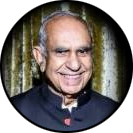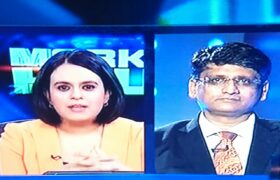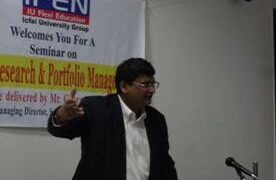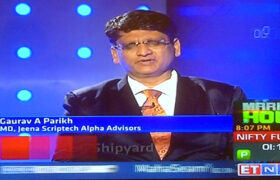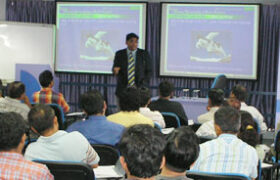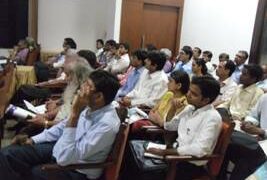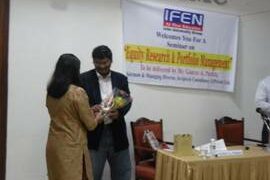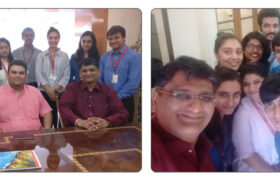R Systems International Ltd
IT Consulting & Software
FV – Re 1; 52wks H/L – 89/53; TTQ – 7736; CMP (May 23, 2016; 1.45 pm) – Rs 56.75;
Market Cap – Rs 720 Crs
Consolidated Financials and Valuations for Q1 FY16 (Amt in Rs Crs unless specified)
Equity Capital |
Net worth |
Long Term Debt* |
Total Sales |
PAT | BV (Rs) |
TTM EPS (Rs) |
TTM P/E |
Industry P/E |
P/BV |
Promoter’s Stake |
Beta |
| 12.61 | 250 | 0.78 | 143 | 7.63 | 20 | 7.27 | 7.84 | 21.73 | 2.85 | 50.8 | (0.02) |
*As of December 31, 2015
Consolidated Financials and Valuations for December ended FY15 (Amt in Rs Crs unless specified)
Equity Capital |
Net worth |
Long Term Debt |
Total Sales |
PAT | BV (Rs) |
EPS (Rs) |
P/E |
P/BV |
| 12.61 | 243 | 0.78 | 610 | 97.83 | 19 | 7.19 | 7.93 | 3.56 |
Company’s MD on his outlook about R Systems ~ ‘I am extremely positive about the outlook for your company. The USA economy is giving mixed signals now but I feel that over the years IT industry has learnt to live in uncertainty’
Valuation Parameters
- EV/EBITDA: 8.26
- EV/Share: Rs 50
- EV/Sale: 1.04
- Market Cap/ Sale: 1.18
- Debt to Equity: ~0
- RoI: 40.26%
Recent Updates
- In its most recent Board Meeting held on April 30, 2015, the Board of Directors approved to Grant 150000 stock options at price of Rs 12.07 per option (i.e. the price at which the options were granted earlier on July 11, 2007) under existing R Systems International Limited Employee Stock Option Scheme 2007 as recommended by the Compensation Committee.
- The Board has also approved opening a subsidiary company of Computaris International Limited, U.K. (wholly owned subsidiary of the Company) in Philippines.
- In FY 15 , the Company issued 90,000 equity shares of Re 1 each at an exercise price of Rs 12.07 per share, pursuant to exercise of employee stock options under the R Systems International Limited Employee Stock Option Scheme 2007.
Other updates
- In 2015, R Systems acquired IBIZ, a Microsoft gold channel partner having ERP and Business Intelligence competencies. IBIZ is having presence in South East Asia. It also acquired a relatively small but strategic telecom IT business in Europe from a renowned telecom operator.
- On July 11, 2014, the Company had incorporated a wholly owned subsidiary in India ~ R Systems Products & Technologies Limited. It was later converted into R Systems Products & Technologies Private Limited (RSPTPL) on May 28, 2015. The shareholders of the Company by passing special resolution through postal ballot on September 23, 2014 had accorded necessary approval for transfer of the Company’s Indus Business Unit operated out of Pune and Chennai to RSPTPL.
- The Company had entered into ‘Business Transfer Agreement’ (BTA) with RSPTPL on June 27, 2015 for the aforesaid transfer on a going concern basis by way of slump sale, for consideration of Rs 78.39 Crs to be discharged by RSPTPL through issuance of 60,000,003 equity shares of Re 1 each at a premium of Rs 6.227 per share and 35,026 compulsorily redeemable debentures of Rs 10000 each, on the terms and conditions agreed in BTA.
- The Company also entered into Share Purchase Agreement (SPA) with BD Capital Partners Ltd. (BDC), a Mauritius based company on June 27, 2015 to sell 93% of its equity share in RSPTPL to BDC for a consideration of Rs 44.32 Crs. Subject to the satisfaction of certain conditions, BDC has also agreed to purchase the balance 7% equity shares for a consideration up to Rs.6.62 Crs. These conditions are under evaluation and yet to be concluded as at the quarter and year ended December 31, 2015. The Company will continue to hold the compulsorily redeemable debentures having an aggregate face value of Rs 35 Crs in accordance with the terms of the BTA. The closing (as defined in the agreements) under the BTA and SPA occurred on July 07, 2015.
- The gain on sale of Indus Business Unit amounting to Rs 56.61 Crs (net of related expenses) and gain on sale of aforesaid equity share in RSPTPL amounting to Rs 2.87 Crs (net of related expenses) is disclosed as ‘Exceptional items’ in the financial results for the year ended December 31, 2015. The name of RSPTPL has been changed to Indus Software Technologies Private Limited w.e.f. August 19, 2015.
- Accordingly, the aforesaid Indus Business Unit, being part of Information technology services and products segment, is considered as “Discontinuing Operations” till July 07, 2015.
- ECnet Limited, a subsidiary of the Company has recorded an impairment loss amounting to Rs 1.2 Crs related to the certain intangible assets acquired in earlier years which is included under ‘Exceptional items’ for the quarter and year ended December 31, 2015.
Overview:
- The Company is engaged in providing Information Technology (IT) Services and Solutions and IT-enabled Services to a range of global customers.
- The Company operates in two segments: Information technology services and products, and Business process outsourcing services.
- The Company’s portfolio of services include the following: Outsourced Product Development through Integrated Product Lifecycle Management (OPD-iPLM) services, application services, testing services, analytics services, business process outsourcing and knowledge process outsourcing services, and packaged services.
- The Company provides its IT services and solutions to a variety of services to organizations in the healthcare industry, telecom and digital media, banking and finance, manufacturing and logistics, and government services.
Consolidated Revenue by Geography in 2015
“SEAC” ~ South East Asian Countries
Management:
- Mr Satinder Singh Rekhi is the MD
- Gen. Baldev Singh (Retd.) is the President and Senior Executive Director
None of the promoter’s holding is pledged
| Major Non-Promoter | % Stake |
| Bhavook Tripathi | 36.7 |
Share Price Trend
Segment Results ~ Amt in Rs Crs
Particulars |
Mar-16 |
Dec-15 |
Mar-15 |
December ended FY 15 |
| Segment Revenue | ||||
| Information Technology Services and Products | 132 | 135 | 135 | 556 |
| Business process outsourcing services | 10 | 11 | 16 | 50 |
| Total | 142 | 146 | 151 | 607 |
| Less: Elimination of Intersegment sales | 0.48 | 0.47 | 0.44 | 1.81 |
| Income from Operations | 142 | 146 | 151 | 605 |
| Segment Results before tax, interest and exceptional items | ||||
| Information Technology Services and Products | 12 | 15 | 15 | 68 |
| Business process outsourcing services | 1.15 | 1.01 | -0.75 | 1.89 |
| Total | 13 | 16 | 14 | 70 |
| Profit Before Tax | 13 | 19 | 13 | 127 |
| Capital Employed | ||||
| Information Technology Services and Products | 112 | 112 | 110 | 112 |
| Business process outsourcing services | 25 | 24 | 16 | 24 |
| Unallocated corporate | 118 | 107 | 81 | 107 |
| Total capital employed | 255 | 243 | 206 | 243 |
| Dividend Trend With Ratios | |||||
| 2015 | 2014 | 2013 | 2012 | 2011 | |
| Dividends (Rs) | 4.9 | 5.85 | 18.5 | 19.6 | 2.4 |
| Dividends % | 490 | 585 | 185 | 196 | 24 |
| Dividend Payout % | 63.14 | 94.35 | 44.21 | 132.79 | 17.9 |
| Dividend Yield% | 6.44 | 6.80 | 4.93 | 8.71 | 1.56 |
Consolidated Financial Trends ~ Amt in Rs Crs
| Particulars | FY 15 | FY 14 | FY 13 | FY 12 | FY 11 |
| Equity Paid Up | 12.61 | 12.67 | 12.59 | 12.45 | 12.24 |
| Networth | 243 | 213 | 232 | 195 | 199 |
| Long Term Debt | 0.78 | 0.63 | 0.88 | 0.34 | 0.38 |
| Total Sales | 610 | 653 | 597 | 466 | 411 |
| PAT | 97.83 | 78.13 | 52.69 | 18.36 | 16.51 |
| EPS (Rs)(adj.)* | 7.76 | 6.20 | 4.18 | 1.46 | 1.31 |
| Book Value (Rs) (adj.)* | 19 | 17 | 18 | 15 | 16 |
- *There was a stock split in the year 20014 ~ sub-division of one equity share of face value of Rs 10 into ten equity shares of face value of Re 1 each fully paid up. The sub-division was effected as per record date of February 28, 2014.
- Net profit for 2015 contains an exceptional profit of Rs 54 Crs as against Rs 18.5 Crs in 2014. The exceptional profit for 2015 mainly relates to sale of Indus product division as against sale of Europe BPO in 2014.
- Revenues for FY15 decreased because of realignment of business activities and divestment of Indus Business Division.
- In FY 15, the Company bought back 678155 fully paid-up equity shares of face value Re 1 each from the open market through stock exchanges.
- Consolidated profits for FY14 include exceptional profit (net of tax) of Rs 18.5Crs. Out of this Rs 16.9 Crs pertains to profit on sale of Europe BPO Business and Rs 1.6 Crs on buy-back of shares of Computaris International Limited (a wholly owned subsidiary).
- Reserves declined in FY14 because the Company paid hefty dividends ~ the Board had recommended a final dividend of Re 0.95 per equity share of face value of Re 1 each. This is in addition to four interim dividends aggregating to Rs 4.90 per equity share of face value of Re 1 each declared during the year ended December 31, 2014. Based on Companies Act, 2013 provisions applicable on the aforesaid dividends, the Company has not transferred any amount to the general reserves as the dividends has been declared and paid after April 1, 2014.
- Proposed Dividend for FY14 was Rs 12.17 Crs which was in line with Rs 12.06 Crs of FY13. The Interim dividend in FY14 stood at Rs 62.43 Crs, way high from that of Rs 13.9 Crs in FY13.



